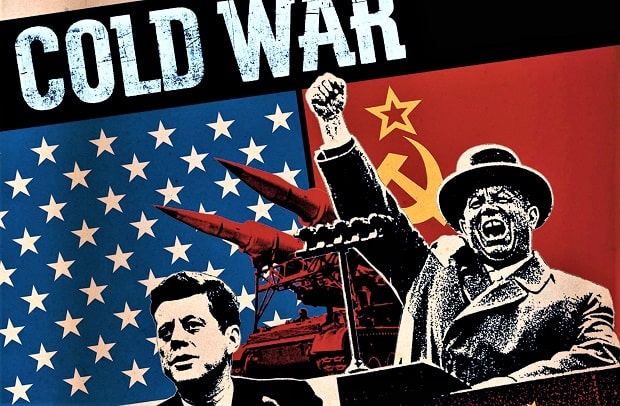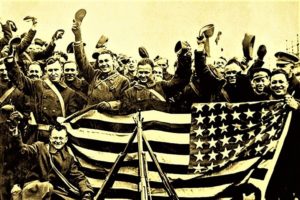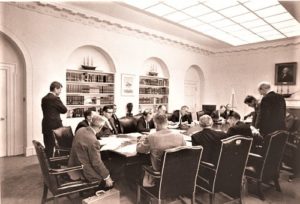
The Cold War was a period of geopolitical tension between the world’s two superpower countries the Soviet Union and the United States and their respective allies, the Eastern Bloc and the Western Bloc, after the finish of World War II. In the second half of the 20th century, they are engaged in a face-off without direct confrontation for almost 45 years. Major European powerful country is weakened after more than 60 million deaths in 6 years of fighting.
Two superpowers remain in the world: the United States of America and the USSR, who fought together as allies to defeat Nazi Germany and the Empire of Japan. The USSR or the Union of Soviet Socialist Republics is a vast area covering one-sixth of the land surface of the planet.
It is a federal-state under a communist regime, consisting of 15 republics and headed by a single party. The United States of America is a liberal democracy based on capitalism. It has a military edge being the only power with nuclear weapons and also boasts the world’s strongest industry and economy.
The Iron Curtain
Both powers try to peddle their influence In Europe. The US, under its Marshall Plan, offers sufficient loans to the European countries to revive their economy and establish trade links with other countries. The USSR, for its part, wants to protect its borders and establish pro-Soviet governments in liberated countries. Europe is found divided into two different blocks and separated by what is known as the Iron Curtain.
In Germany, allies merge areas they control, in infringement of agreements signed with the USSR. In response, the USSR imposes a blockade on West Berlin, which is still under allied control. An airlift is set up to bring supplies to the area.
Divisions
Henceforth, both powers harbor a fear of the other. On both sides begins a witch hunt. In the United States, federal employees sympathetic to Communist ideas are fired. Even Hollywood is used as a tool to produce anti-communist propaganda.
In the USSR, any form of opposition is suppressed. Past belief system and clout, the two powers battle for impact in the fields of science, industry, space, sports, and military. The Soviet Union invests heavily in his manufacturing industry and arms, and in 1949 the Soviet Union tested its first nuclear bomb. The same year, the United States set up NATO, a military alliance between countries of the Western bloc
Influence Wars
Throughout the Cold War, there would be many indirect encounters between the two superpowers and their allies. The first one takes place in Greece where a rebel communist militia from the Second World War, supported by the Soviets and armed by Yugoslavia, enters into a civil war against the traditional monarchist party, supported and financed by Britain and then the United States.
However, following tensions, the USSR breaks its alliance with Yugoslavia. As a result, Greek communists lose vital support and are forced to lay down their arms. Greece then becomes part of the Western bloc.
Wars in Asia During the Cold War
In China, after 3 years of civil war, the communists prevail over the nationalists who retreat to Taiwan. The USSR wins a crucial ally in the region that would impact two wars in special. The first was fighting alongside Communist North Korea against South Korea, which was supported by a United Nations-led international force directed by the United States.
After 3 years of fighting, a ceasefire leaves the Korean peninsula divided into two. China also intervenes in French Indochina where it supports a rebel communist militia against France, which after struggling to regain control of its former colony, is forced to leave the region.
Vietnam is divided into two at the 17th parallel, with communists in the north and nationalists in the south supported by the United States. This marks the beginning of the Vietnam War.

China breaks its alliance with the USSR, as the country aims to distance itself and become a new world power. On the other hand, many countries break with the two main camps and choose to remain neutral by creating the Non-Aligned Movement. In Latin America, the United States plays its part to ensure no room for communism. But the country fails to militarily overthrow the new communist government in Cuba.
In Vietnam, the United States fearing a Communist takeover of the south organizes a military invasion with more than half a million soldiers. The decision antagonizes France, which prefers to find a peaceful solution. France chooses to remove itself from the increasingly assertive The United States and leaves NATO. In 1975, communists win the war, inflicting a heavy defeat for the United States, whose image is tarnished globally.
Cuban Missile Crisis
The united states and USSR faced off across the globe, each knew that the other had atomic weapons capable of destroying it. And destruction’s never loomed closer than during the 13 days of Cuba missile crisis. In 1961, the US unsuccessfully tried to overthrow Cuba’s new communist government.
That failed attempt was known as a bay of pigs, and it convinced Cuba to seek help from the USSR. Soviet premier Nikita Khrushchev was happy to comply by secretly deploying nuclear missiles to Cuba, not only protect the island but counteract the threat from US missiles in Italy and Turkey.
By the time US intelligence discovered the plan, the materials to create missiles were already in place. At an emergency, meeting on October 16, 1962, military advisor’s waged an airstrike on missile sites and invasion of the island.
But President John F. Kennedy chose a more careful approach. he announced that the US Navy would intercept all shipments to Cuba. A naval blockade was considered an act of war. The President called it quarantine that did not block baric necessities, USSR did appreciate the distinction.
Khrushchev wrote a letter, “The violation of freedom to use international waters and international airspace is an act of aggression which poster mankind towards the abyss of a world nuclear-missile war.” The US demanded the removal of a missile, Cuba, and USSR insisted they were only defensive as weapons continued to arm, the US prepared for a possible invasion. On October 27 spy plane piloted by Major Rudolf Anderson was shot down by USSR.

The same day nuclear-armed soviet submarine was hit by a small depth charge from US Navy vessel trying to signal it come up. Commanders on dub too deep communication with the surface thought the war had begun and prepared to lunch nuclear torpedo.
The decision had to made by three officers. The caption and the political officer both authorized the lunch, but second in command refused. Saved the day and perhaps the world. US military set itself DEFCON 2, the defense one step away from nuclear war.
In Washington D.C, Attorney general Robert Kennedy secretly meet with USSR ambassador “Anatoly Dobrynin”. After intense negotiation, the USSR agrees to withdraw and remove its military facilities if in return the US promises not to attack Cuba and removes its missiles in Europe. President of the USSR announcing the missiles would be removed from Cuba. The crisis was over now.
The Fall of the USSR
In 1919, Soviet President Mikhail Gorbachev announced we are living in a new world, and with those several words soviet union was dissolved and Gorbachev stepped down from his position. After 45 years of the cold war and the threat of nuclear holocaust, the world’s largest communist country broke up into 15 independent republics. It means the USA was now handed the accolade of the new world superpower.
At strongest, USSR had over 5 million soldiers stationed around the world and all stepped down. Without a shot being fired under a new regime. In the late 1980s, USSR appeared to be somewhat of a powerhouse, exhibiting a rigid recovery from the invasion of Afghanistan, and with the economy that appeared roper forming well. The Union of soviet socialist republics. “Russian revolution of 1917, formally established in 1992.
15 sub-national soviets, centralized economy and planning, one-party rule. “Communist party” ARMS Rave Nuclear arsenal largest in the world, Billion spent on huge army, mutually assured destruction. USSR army also knows as the red army. USSR increase there influence they support to Cuba, North Korea, Vietnam, Laos, China, and many other communist nations. Material and technology spent these nations cost of money. This makes the end of the Cold War.
Drawback
Tight state control over the economy and the absence of free-market economy was draining the USSR economic strength. The decline of December 6, 1991, of the USSR. 1962 was USSR takes his nuclear missile on Cuba state. Cuba was a central point of the cold war.
[…] Soviet nuclear missiles. The struggle that ensued between the United States and the Soviet Union, the Cuban Missile Crisis, brought the world nearby, it has ever come to a nuclear […]